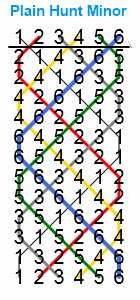Most people start to learn Plain Hunt by remembering the bells they ring after. It must be stressed that as soon as possible, you should start counting places as this is essential when you move on to more complicated things. The places are important as they give an indication of the speed to ring at. When counting UP, you will have to ring slower than in rounds. When counting DOWN, you must ring quicker in order to be able to follow the correct bell. For a detailed explanation of what is meant by quicker or slower visit the
Ringing Speed page.
The table below describes the work of every bell. It may help you if you colour in the bell you are learning with a highlighter pen - On paper not the screen! Don't just learn one bell, there may be occasions when there is more than one learner so it will be no good if you all want to ring the same bell.
In Plain Hunt Minor, the tenor is a working bell, because of this you must lead from the last bell (the one in sixth place) on the previous row. Many people misread method diagrams for Minor methods and think they have to ring after the last bell on the row they are in. Thinking about it, if you are the first bell to ring in the row as you are leading, you can't follow the six placed bell as it hasn't rung yet. The table below should clarify the matter.
The Work of all Bells in Plain Hunt Minor
Change ⇒
Handstroke / Backstroke ⇒ |
R
o
u
n
d
s |
1st
H |
2nd
B |
3rd
H |
4th
B |
5th
H |
6th
B |
7th
H |
8th
B |
9th
H |
10th
B |
11th
H |
R
o
u
n
d
s |
| |
| Treble Counts Places | | 2 | 3 | 4 | 5 | 6 | 6 | 5 | 4 | 3 | 2 | L | L |
| Treble Rings after | 6 | 2 | 4 | 6 | 5 | 3 | 2 | 4 | 6 | 5 | 3 | 4 | 6 |
| |
| Second Counts Places | | L | L | 2 | 3 | 4 | 5 | 6 | 6 | 5 | 4 | 3 | 2 |
| Second Rings after | 1 | 6 | 5 | 4 | 6 | 5 | 3 | 1 | 4 | 6 | 5 | 3 | 1 |
| |
| Third Counts Places | | 4 | 5 | 6 | 6 | 5 | 4 | 3 | 2 | L | L | 2 | 3 |
| Third Rings after | 2 | 4 | 6 | 5 | 1 | 2 | 4 | 6 | 5 | 2 | 4 | 1 | 2 |
| |
| Fourth Counts Places | | 3 | 2 | L | L | 2 | 3 | 4 | 5 | 6 | 6 | 5 | 4 |
| Fourth Rings after | 3 | 1 | 2 | 5 | 3 | 6 | 5 | 3 | 1 | 2 | 6 | 5 | 3 |
| |
| Fifth Counts Places | | 6 | 6 | 5 | 4 | 3 | 2 | L | L | 2 | 3 | 4 | 5 |
| Fifth Rings after | 4 | 6 | 3 | 1 | 2 | 4 | 6 | 1 | 2 | 3 | 1 | 2 | 4 |
| |
| Tenor Counts Places | | 5 | 4 | 3 | 2 | L | L | 2 | 3 | 4 | 5 | 6 | 6 |
| The Tenor Rings after | 5 | 3 | 1 | 2 | 4 | 3 | 1 | 5 | 3 | 1 | 2 | 4 | 5 |

